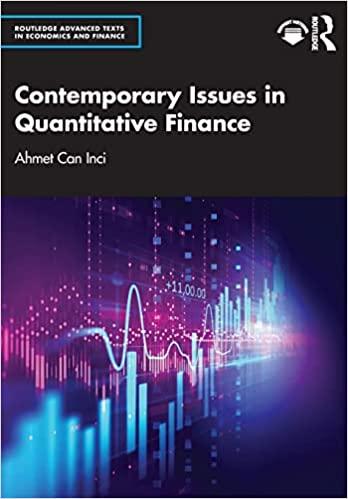Question
Rent versus Own Analysis This project requires you to compare the costs of owning a home against renting a home. Assume a home can be
Rent versus Own Analysis
This project requires you to compare the costs of owning a home against renting a home. Assume a home can be purchased for $150,000 with a $30,000 down payment and financed with a fully amortizing mortgage loan of $120,000 at 4.5 percent interest for 30 years. Other costs associated with owning include annual maintenance (initial cost of $600), insurance (initial cost of $600), and property taxes (initial cost of 1.5 percent of property value). These expenses would not need to be paid if renting. Assume that growth rates for expenses (including insurance, maintenance, and property taxes) equal to 2 percent per year. Assume the property value will grow at a rate of a constant 2 percent per year. After six years, the property will be sold. A selling expense of 7 percent would have to be paid at that time. Assume the income tax rate is 24 percent. Alternatively, assume the home can be rented for $12,000 for the first year, with an annual 2 percent growth rate in rent.
Be sure to show your work in Excel. In other words, do not simply type values into the boxes, but reference prior cells when calculating results. Please refer for Exhibits 7-2 and 7-3 for sample calculations. In your report, identify and explain the net cash flow in each year, for owning relative to renting. If an annual after-tax return of 15 percent is available on an investment of comparable risk, which is the better option, owning or renting?
Part 1: Property and Loan Information
- Fill in the table for the property information. (9 points)
- Fill in the table for the loan information. Apply the Excel PMT function to calculate the monthly payment. (9 points)
Formulae: Interest = Beginning loan balance * Periodic rate
Amortization = Monthly payment Interest
Ending loan balance = Beginning loan balance Amortization
Part 2: Loan Schedule
- Fill in the table for the loan schedule over six years. Make sure you reference cells (e.g., monthly payment and periodic rate). (9 points)
- Fill in the table for the yearly summary of the loan schedule. These values should be referenced from Section C. For example, Interest for year 1 would be the sum of Interest in months 1 through 12. (9 points)
- Fill in the table for the yearly property data. Apply the FV function or FV formula using correct growth rates. (9 points)
Part 3: Cash Flow Analysis
- Fill in the table for the before tax cash flows from owning. Apply the FV function or FV formula to calculate the property taxes, insurance, and maintenance after year 1. Reference the Interest and Principal from Section C. (9 points)
Formulae: Property taxes = Property value * Property tax rate
Cash outflows before taxes = Property taxes + Insurance + Maintenance + Principal + Interest
- Fill in the table for tax deductions. Reference the property taxes from Section F and Interest from Section D. (9 points)
Formulae: Total tax deductions = Property taxes + Interest
Tax savings = Total tax deductions * Income tax rate
- Fill in the table for net cash flows from owning. Reference the Cash outflows before taxes from Section F and the Tax savings from Section G. Reference the cost of renting from Section E. (9 points)
Formulae: After tax cost of owning = Cash Outflows before taxes - Tax savings
After tax cash flows Own vs. Rent = Cost of renting - After tax cost of owning
- Fill in the table for the cash flows from selling the home in year 6. Reference the Property value from Section E and the Loan balance from Section D. (9 points)
Formulae: Selling costs = Property value * Selling expense rate
Benefit from sale = Property value Selling costs Loan balance
- Fill in the table for the net cash flows. Items to include in the net cash flow consist of the down payment (cash outflow), After tax cash flows Own vs. Rent foe each year, and the Benefit from Sale. Calculate the internal rate of return (IRR) using the Excel function. (9 points)

Step by Step Solution
There are 3 Steps involved in it
Step: 1

Get Instant Access to Expert-Tailored Solutions
See step-by-step solutions with expert insights and AI powered tools for academic success
Step: 2

Step: 3

Ace Your Homework with AI
Get the answers you need in no time with our AI-driven, step-by-step assistance
Get Started


